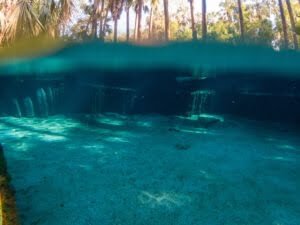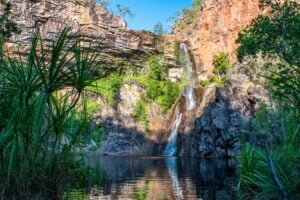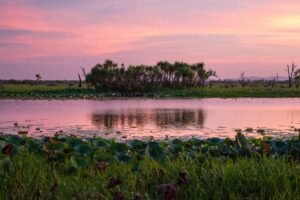The Gibb River Road, also known as the Gibb or GRR, is the most iconic track of the Kimberley. Once (and to a lesser degree, still) a stock route for cattle stations to the port towns of Derby and Wyndham, the Gibb is 660 kilometres of remote wilderness, showcasing some of the region’s best gorges, waterholes, and scenery. The Gibb is definitely more tent or camper trailer-friendly; however, it is doable with a caravan provided you have the right setup. An off-road caravan and 4WD tow vehicle are pretty much a necessity as you are likely to encounter numerous water crossings and some serious corrugations depending on the time of year you visit. Don’t have an off-road caravan and/or 4WD? Don’t despair! There are some highlights at either end of the Gibb that are still reachable towing a standard caravan or as a day trip from the larger towns at either end of the track. Because of timing of bookings and others coming over to join us on the Gibb, we ended up doing the Gibb three times in five weeks! Having been such a massive wet season prior, it gave us an opportunity to see almost everything we wanted to as there were a lot of delayed openings for places.
One thing we highly recommend is getting a copy of Birgit Bradtke’s “Destination Kimberley” guidebook. It has so much useful information on the Gibb from a local who knows it intimately; we used it as a resource constantly during our time in the Kimberley. It can be found at www.kimberleyaustralia.com.
HORIZONTAL FALLS
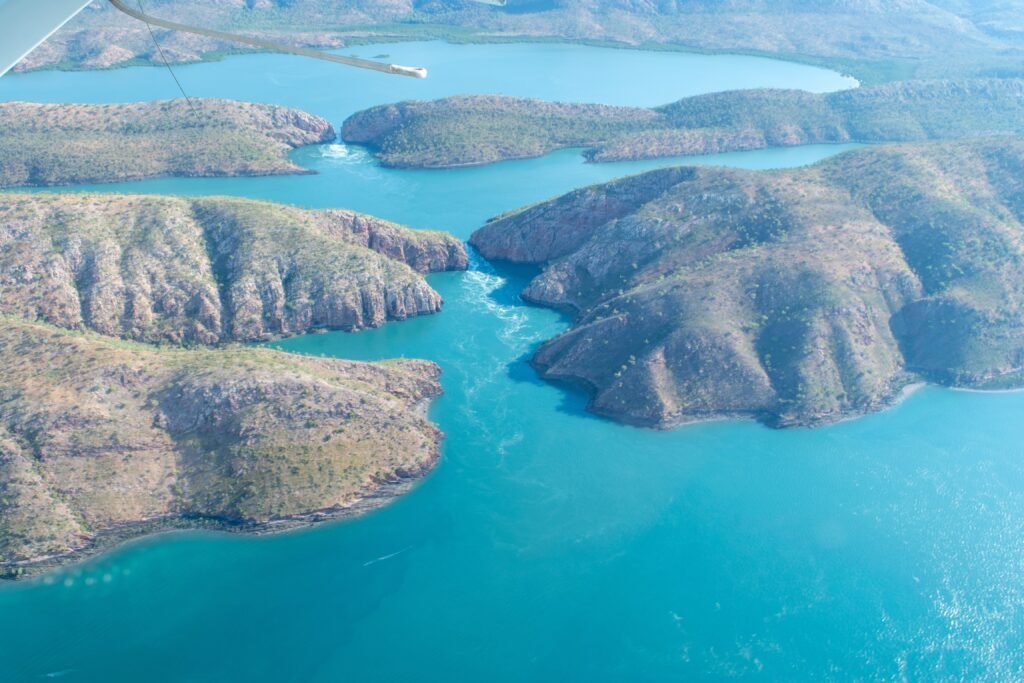
Even though this isn’t part of the Gibb officially, a lot of people start or finish their Gibb journey with a trip to Horizontal Falls. David Attenborough described it as one of the world’s greatest natural wonders. Being one of our all-time favourite experiences (ever!) we just had to share it.
Flights to Horizontal Falls leave from either Broome or Derby, with Derby being the slightly cheaper option (and the official end/start of the Gibb). There are multiple tour options, the day tour being the most popular but the overnight tour being the most recommended, so that’s what we went with. For not much more than the cost of the day tour, you get an extra boat trip through the falls and spend the night on a fantastic house boat. We definitely did not regret it!

The tour starts off with an awe-inspiring scenic flight on a sea plane to the falls. Following along the fairly untouched Buccaneer Archipelago, which is made up of more than 1,000 islands, you come in for a dramatic landing on the water and taxi to the barge.
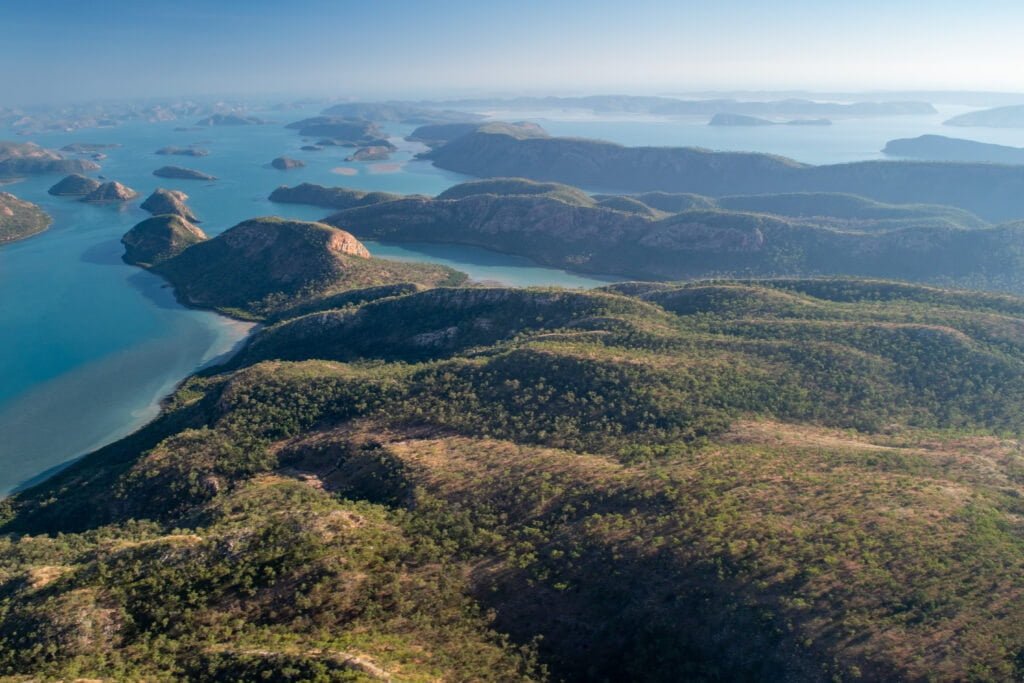
From here, depending on the tides you do either one of two things. The first is to watch the shark feeding. Most of the sharks are tawny nurse sharks, with the occasional bull shark popping up for a feed. There’s also the option of getting into the water and seeing the sharks underwater from the glass viewing area with snorkels and masks provided.
The other activity is the main attraction: the jet boat ride through the falls. The excitement is palpable as you board boats with 4 x 300 horsepower engines and take off to the falls. The “falls” themselves come from the massive tidal movements in the area: as the water recedes from the two gaps (known as the Wide and Narrow Gaps), it has no where else to go but out, and therefore rushes out at mind-boggling volumes, creating an impressive horizontal waterfall effect. After a quick introduction, the trips through the falls of the Wide Gap, which is about 20 metres wide, begin and no description can fully describe the exhilaration.
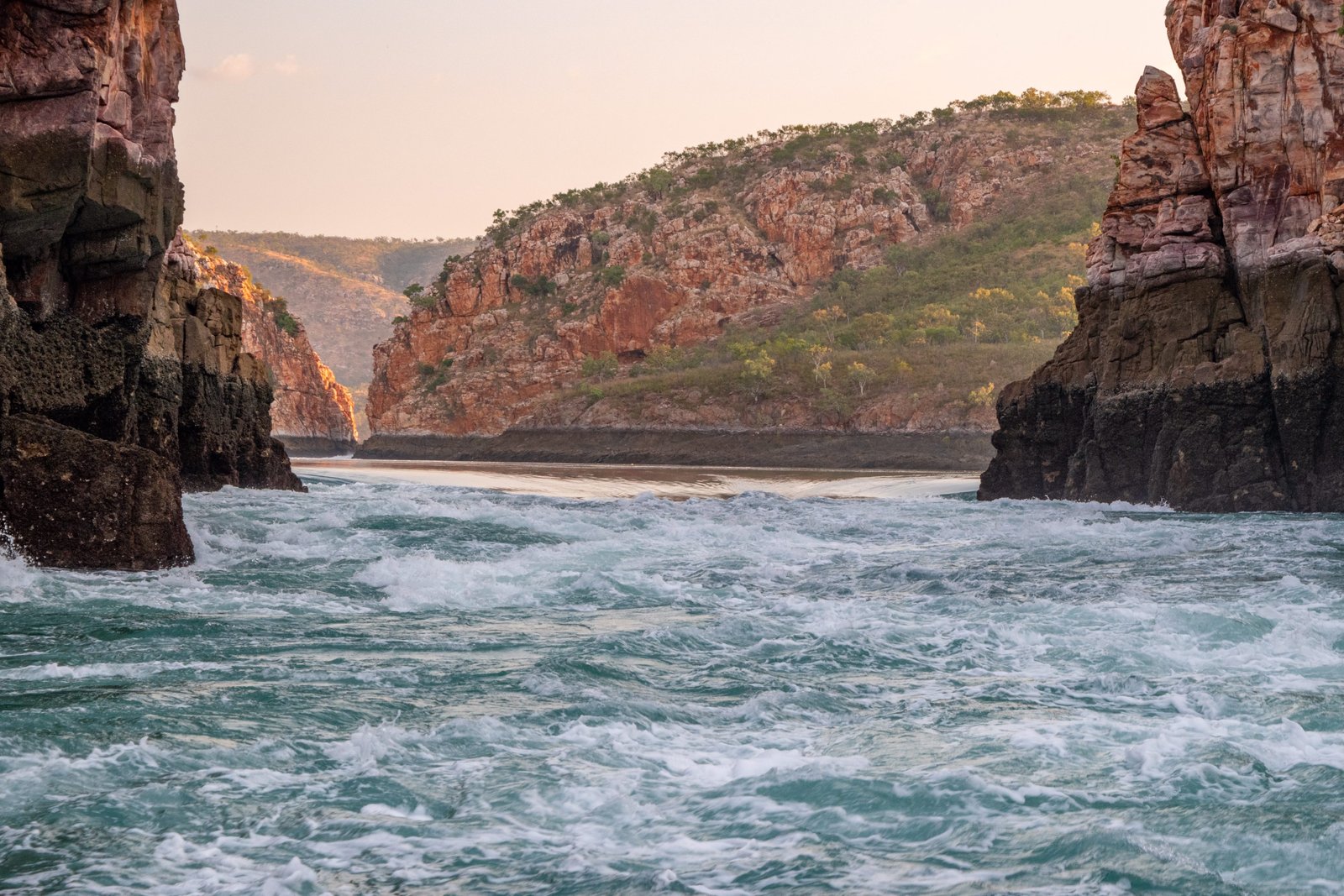
After a few trips through, the boat heads for the Narrow Gap, which is a mere 9 metres wide. The difference in the rush of water through this smaller gap is extraordinary. The jet boats can only go through this gap when the change in water height is 1.5 metres or less; the height difference can get up to 4+ metres. When we first saw the Narrow Gap, the height was at approximately 3 metres meaning we definitely could not ride through it, but we got up nice and close to experience that impressive rush of water. Finally, after all that excitement, you finish off with a scenic sunset cruise around the area before coming back to the barge for drinks and dinner.
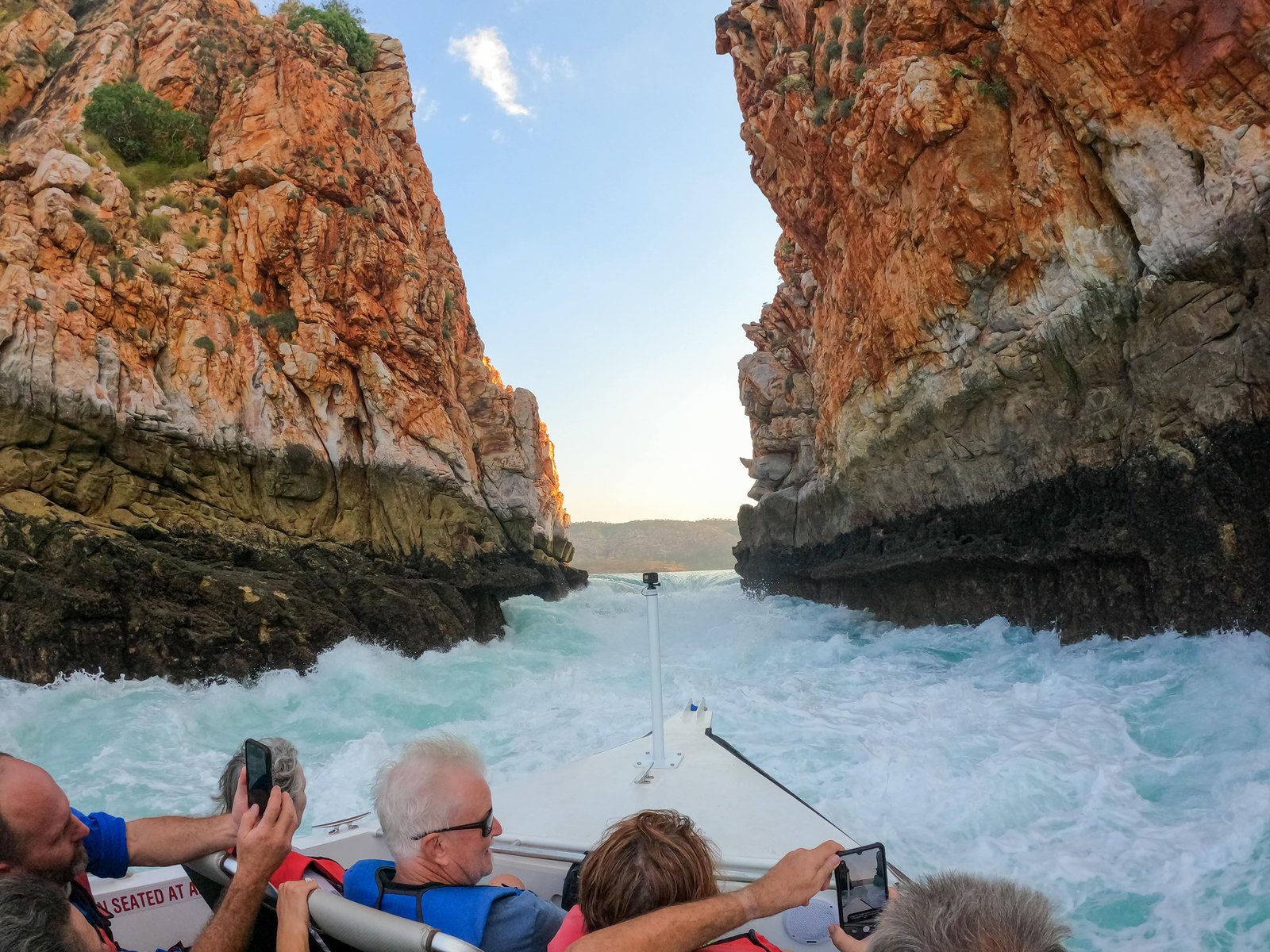
Luckily, the beauty of doing the overnight stay and having a second trip through the falls meant that we had another opportunity to give it a go. The next day the height difference of the water coming out of the Narrow Gap was at 0.9 metres, and just like with the Wide Gap we had a few thrilling runs through it. Then we came back to the barge to have another scenic flight back to Derby. It was an experience we’ll never forget!
Our top tips for the Horizontal Falls Tour? Try to book in what’s known as spring tides, when the difference between high and low tide is at its biggest (usually around 9-10 metres); you’ll get the most impressive falls during this time. If you’re stuck with a particular date, don’t worry; the tours only run during the bigger tides so you’ll still have a worthwhile experience no matter what. Also, go for the overnight stay if you can. In the scheme of things, it’s not that much more expensive than the day trip, and you get so much more out of it, like the second ride through the falls. Make sure to book ahead; this is a very popular tour and books up quickly during the tourist season. Lastly, on the jet boats, obviously the front row has the best seats, but any outer seats will give you the full effect and the best opportunity for photos.
Now on to the Gibb…from Derby to Manning Gorge, here are the must-see highlights of the western portion of the Gibb.
DERBY
Derby mainly serves as a stocking up point for Gibb travels, but it is still a nice town to spend a bit of time in. A visit to the Derby jetty shows off the impressive tidal movements of the region; try to see it once at low tide and then again at high tide (especially during spring tides) to get the full effect. There is also AMAZING pizza at the Jila Gallery Cafe. The Prison Tree is worth visiting to learn about one of the most shameful times in Australian history. This large boab was once used as a holding cell for Aboriginal people who were being transported for various purposes such as slave labour for the pearling industry.

WINDJANA GORGE AND TUNNEL CREEK

While not officially on the Gibb River Road, this slight detour is well worth it. The road from Derby up to the turn-off is sealed, then the track to Windjana Gorge and Tunnel Creek, while unsealed, is usually in good condition with minimal corrugations, which makes it easily accessible, even in a standard car, as a day trip from Derby.
Windjana Gorge (Bandilngan) is a deep pool framed by high gorge walls that form part of the Napier Range, which was once an ancient barrier reef system approximately 375 million years ago. There is a walking trail through the gorge (3.5km one way), but most visitors come here for the crocodiles. It is one of the best places along the Gibb to see freshwater crocodiles as they float lazily in the water or sun themselves on the banks or exposed rocks and logs. The later in the season it gets, the more dried up the waterhole becomes, and the more visible the crocodiles are.
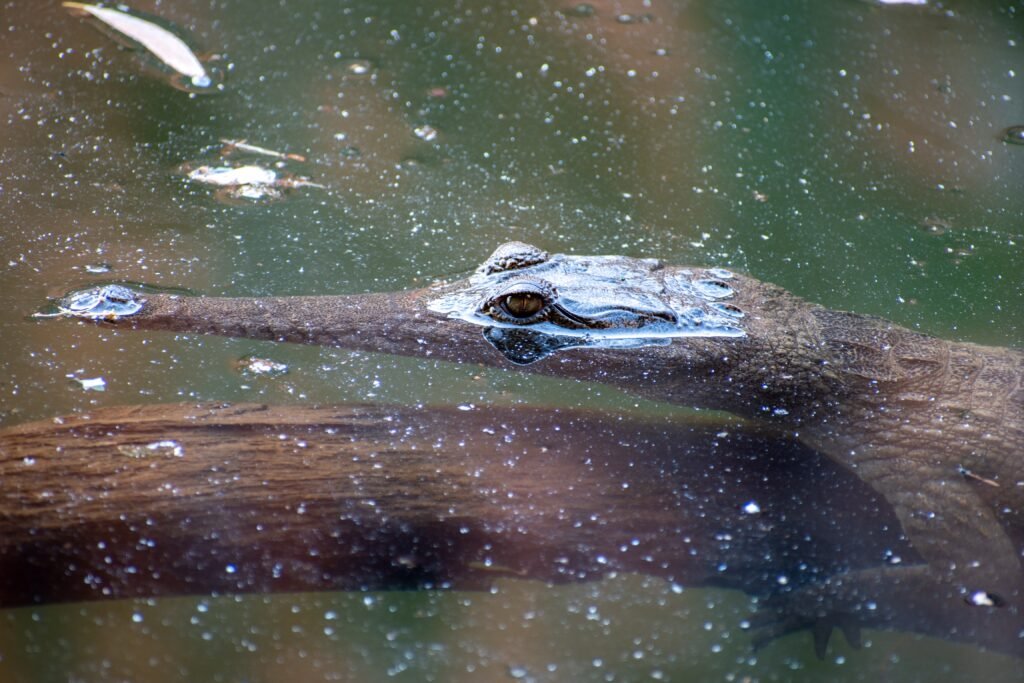
Approximately 35 kilometres south of Windjana lies Tunnel Creek (Dimalurru), one of the more adventurous attractions along the Gibb. You will need a good torch (preferably a head torch) and shoes that can get wet. The 750m trail involves walking, sometimes wading or even swimming, through a cave system, which can be pitch-black. While there are crocodiles here, they are luckily only the freshwater type, which are not aggressive. The far end of the tunnel offers a peaceful respite and, for the keen eye, ancient Aboriginal artwork. Tunnel Creek is also part of the Pidgeon Heritage Trail, the setting for the compelling story of Jandamarra (also known as Pigeon), a Bunaba man who became an outlaw due to conflict with European settlers in the late 1800s. Tunnel Creek is where Jandamarra’s saga met its dramatic end when he was fatally wounded during a shoot out with the police.
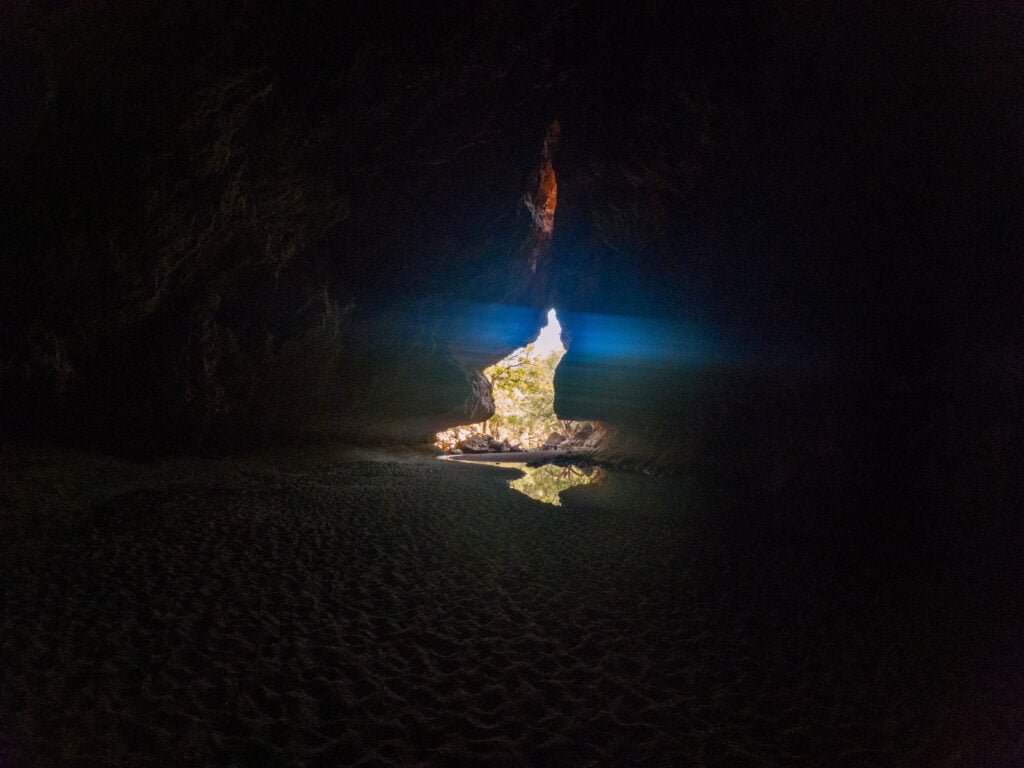
If heading south from Tunnel Creek to Fitzroy Crossing, we highly recommend the free camp at the RAAF Quarry. It’s an idyllic spot with a great swimming hole and several Devonian caves to explore.
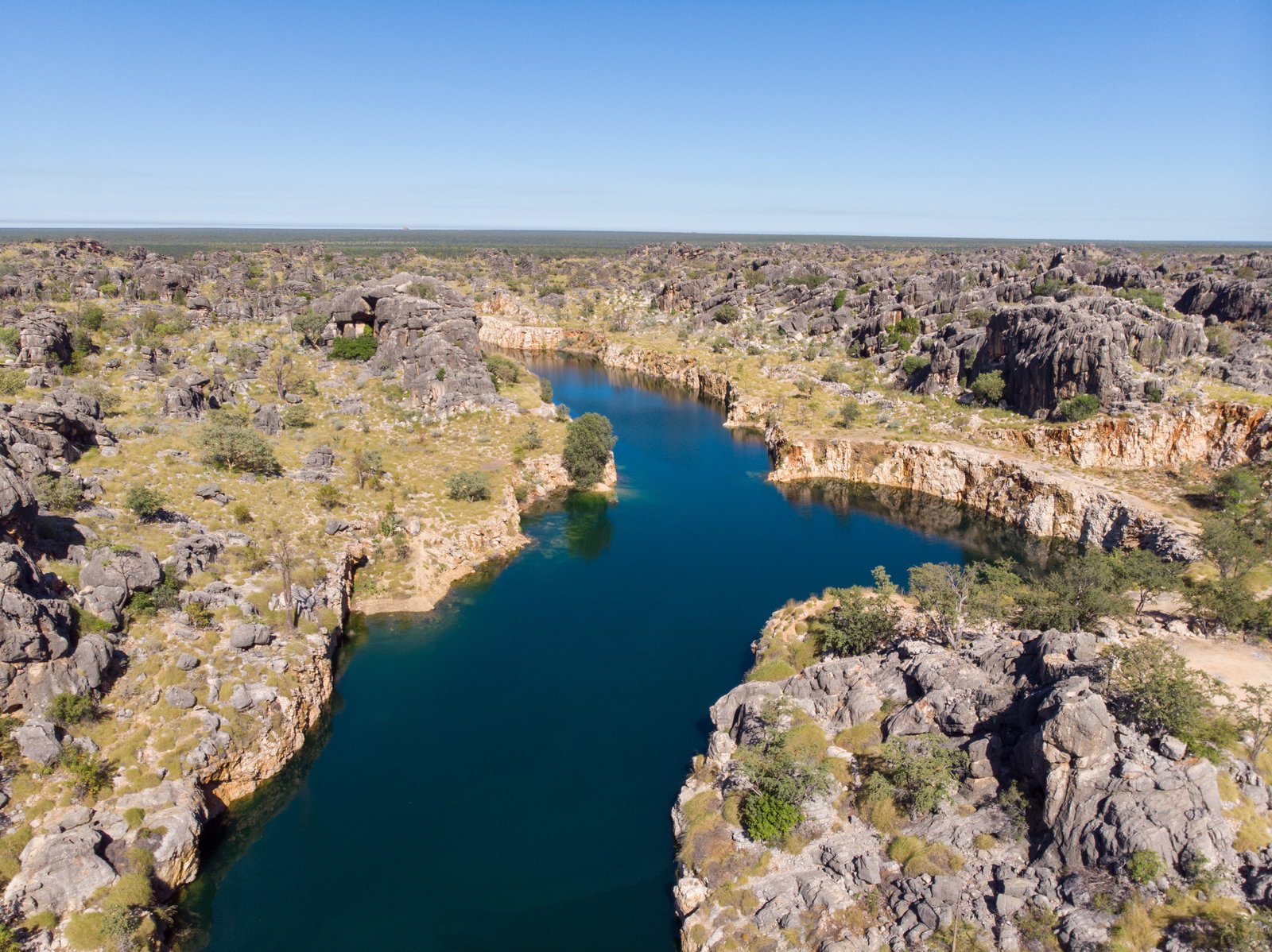
MOUNT HART
Now Mount Hart Station doesn’t have the show-stopping gorges and swimming holes that the Gibb is most known for, but it is a good option for early season visits because it tends to be one of the first stations to open in the season and has some lovely spots worth a look.
Barker Pool is a nice large swimming hole great for cooling off on a hot day. Watch out for the small freshwater crays that may be tempted to give your toes a little pinch! Dolerite Gorge is a lovely walk that can be challenging due to the need for boulder hopping as you crisscross the creek a couple times but it leads to some lovely and usually fairly private swimming holes.

BELL GORGE
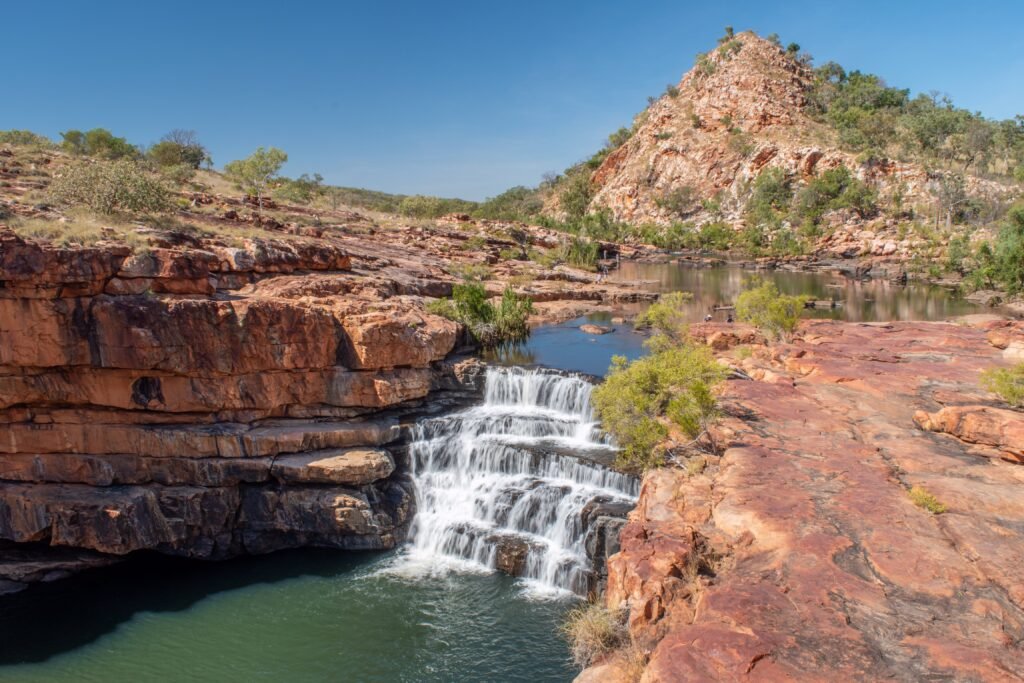
Many consider Bell Gorge to be one of the best spots along the Gibb, and rightly so – this multi-tiered waterfall is magnificent. However, due to its popularity, during the peak season rangers sometimes have to close the carpark when it gets to capacity, so make sure you get in early during the busier months. The gorge is a 30km (one-way) detour from the Gibb, with a Parks-run campground about 20km in. Another nearby camping option is Imintji Store, which offers unpowered camping with great facilities (toilets, showers, bbqs, fire pit, picnic tables).
The walk to Bell Gorge is fairly easy until you get to the falls, where the track then requires you to navigate rock-hopping or wading through a flowing creek and a steep walk down into the gorge. You can always just admire the falls from the top but much more awaits at the bottom: a great swimming hole, plenty of rock space to relax on, and waterways to explore further downstream (or upstream).
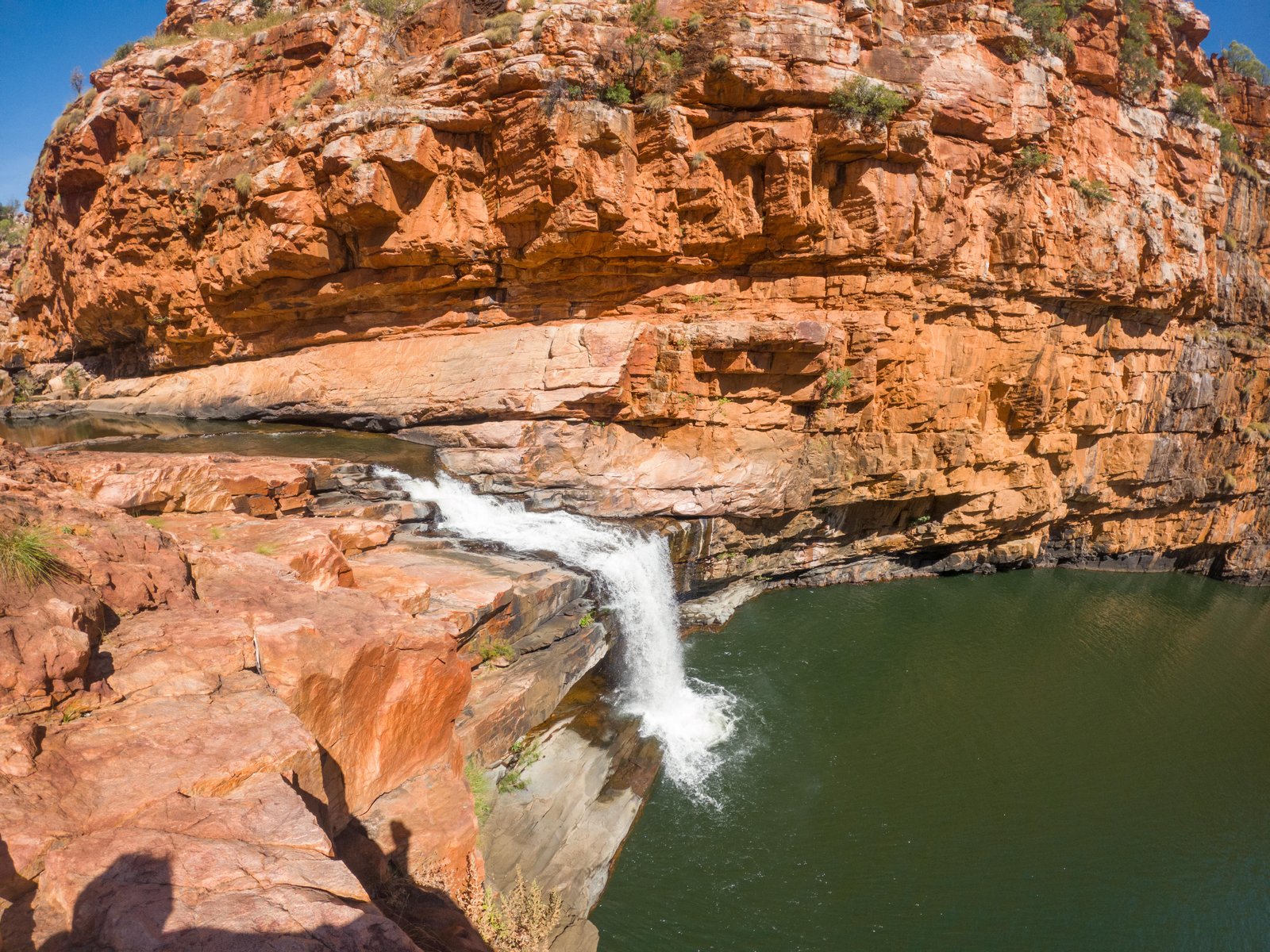
LENNARD GORGE
Lennard Gorge is probably one of the least known gorges along the Gibb. It’s a short but challenging walk (rough and uneven ground, undulating terrain) which leads to a beautiful lookout over the gorge. Unofficially there is a way down to the bottom that we probably would have done had it not been late afternoon, which meant we needed to head off to find a campsite soon. Apparently they are doing this spot up, so there may be official access in the not too distant future which would make this a top spot.

ADCOCK AND GALVANS GORGE
Adcock and Galvans Gorge are small detours from the main track and can easily be done on the way to somewhere else. Being one of the lesser known gorges of the Gibb and requiring a bit of 4WD’ing to get to, Adcock Gorge is one you’re more likely to have to yourself. It has some little caves to explore and a bit of cliff-jumping if you’re keen (be careful, it is slippery!).
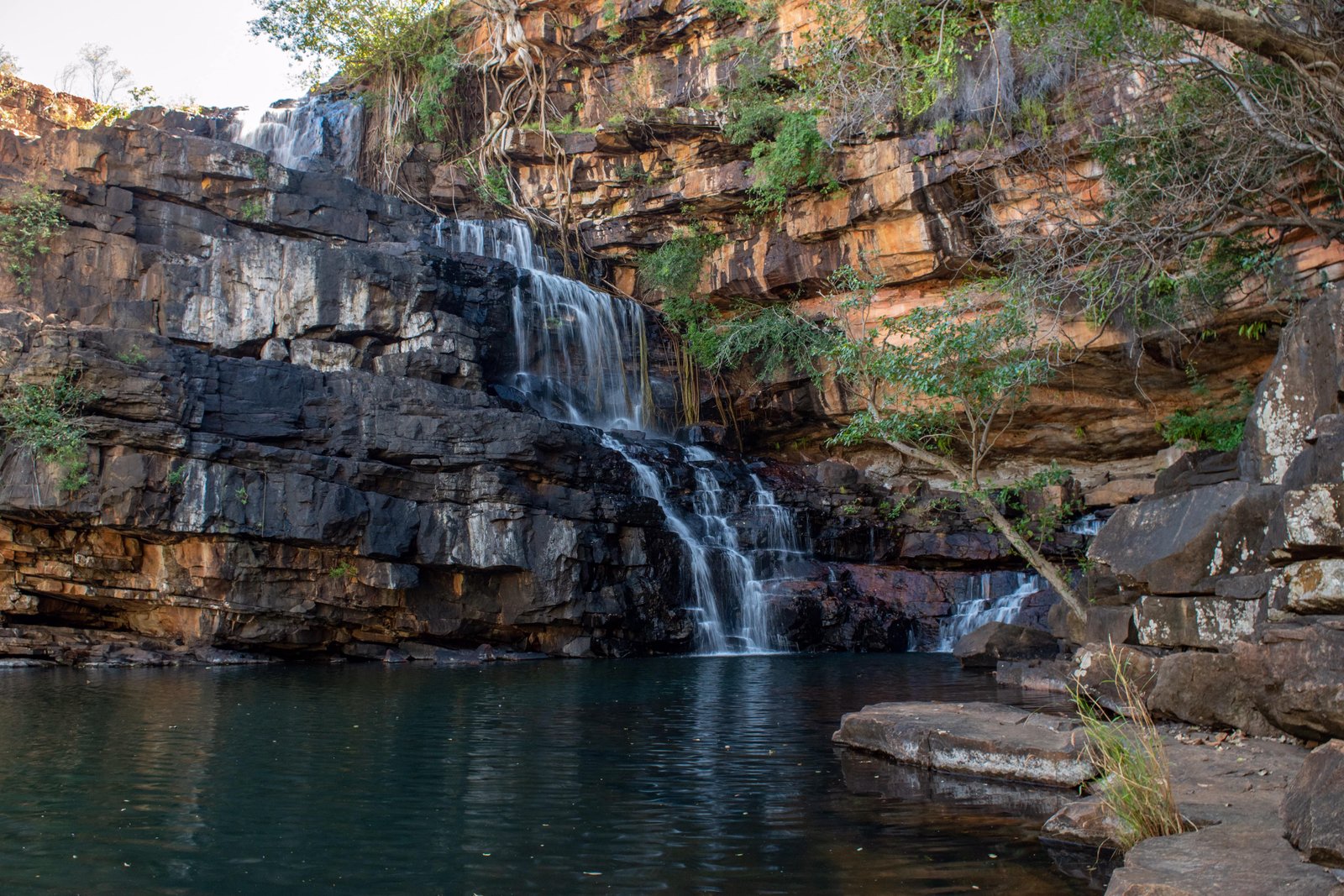
Galvans Gorge is a short 1km walk from the carpark, and timing is key: the area around the gorge and swimming hole is fairly small and can easily fill up if there’s a tour group or two there, which does happen from time to time with it being so easily accessible. Nevertheless it is a picturesque waterhole with a large iconic boab towering over it. There is a way to the top of the falls, but really it’s more impressive from the bottom. At Galvans you’ll also find a great example of the Wandjina style of Aboriginal rock art; swim to the right of the falls and have a look under the overhang.

CHARNLEY RIVER STATION AND MORNINGTON WILDLIFE SANCTUARY
Charnley River and Mornington are both owned by the same organisation, the Australian Wilderness Conservancy. This not-for-profit organisation rehabilitates properties all across Australia, turning them into wildlife sanctuaries. These are some of the less touristy stations on the Gibb but are quite popular with Kimberley locals. They are relatively far off the main track, especially Mornington, so if visiting these places, you’ll almost certainly need to bring extra fuel or top up at nearby Imintji Roadhouse.
Charnley River is the more accessible spot and is caravan-friendly, whereas Mornington is not. Mornington limits their camping numbers a bit more and therefore tends to get booked out a lot quicker than Charnley; it almost always needs to be booked ahead of time. Usually (depending on the season) you can just rock up at Charnley and get a camp spot. The AWC offers nightly informational talks; you’ll get the same spiel at both places so seeing it once is enough but it is interesting to see all the work that they do across the country.
Charnley River Station offers self-guided tours of the property; you get a guidebook for a $10 deposit from reception. Dillon Gorge is a great swimming hole; it’s quite long, so you can explore as little or as much as you like up and downstream.
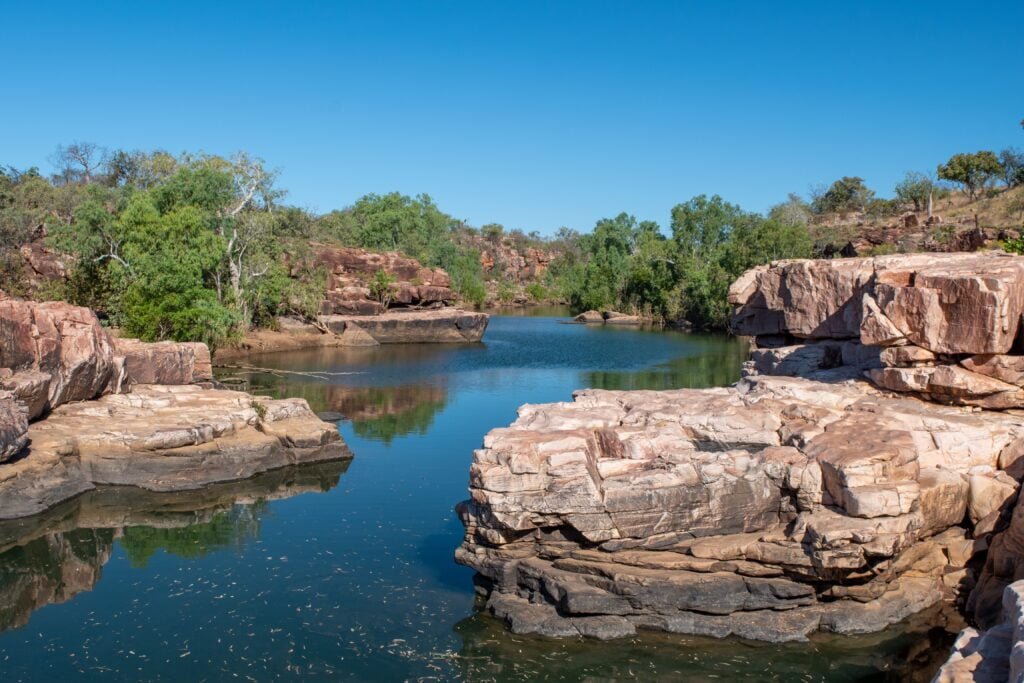
We were underwhelmed by Grevillea Gorge; it’s another place that you can unofficially explore further into the gorge but it is very clear that management discourages it (and we couldn’t see any obvious ways down). Also, the lookouts don’t really show much of the gorge or the waterfalls. Lilly Pools and Donkey Pools are both delightful waterholes; chances are good that you’ll spot some wildlife as you walk around.

The main highlights at Mornington Wilderness Camp are Dimond Gorge and Sir John Gorge. For Dimond Gorge, we highly recommend hiring canoes to properly experience this place; otherwise, this beautiful gorge can be a bit of a let-down as it is fairly inaccessible on foot.
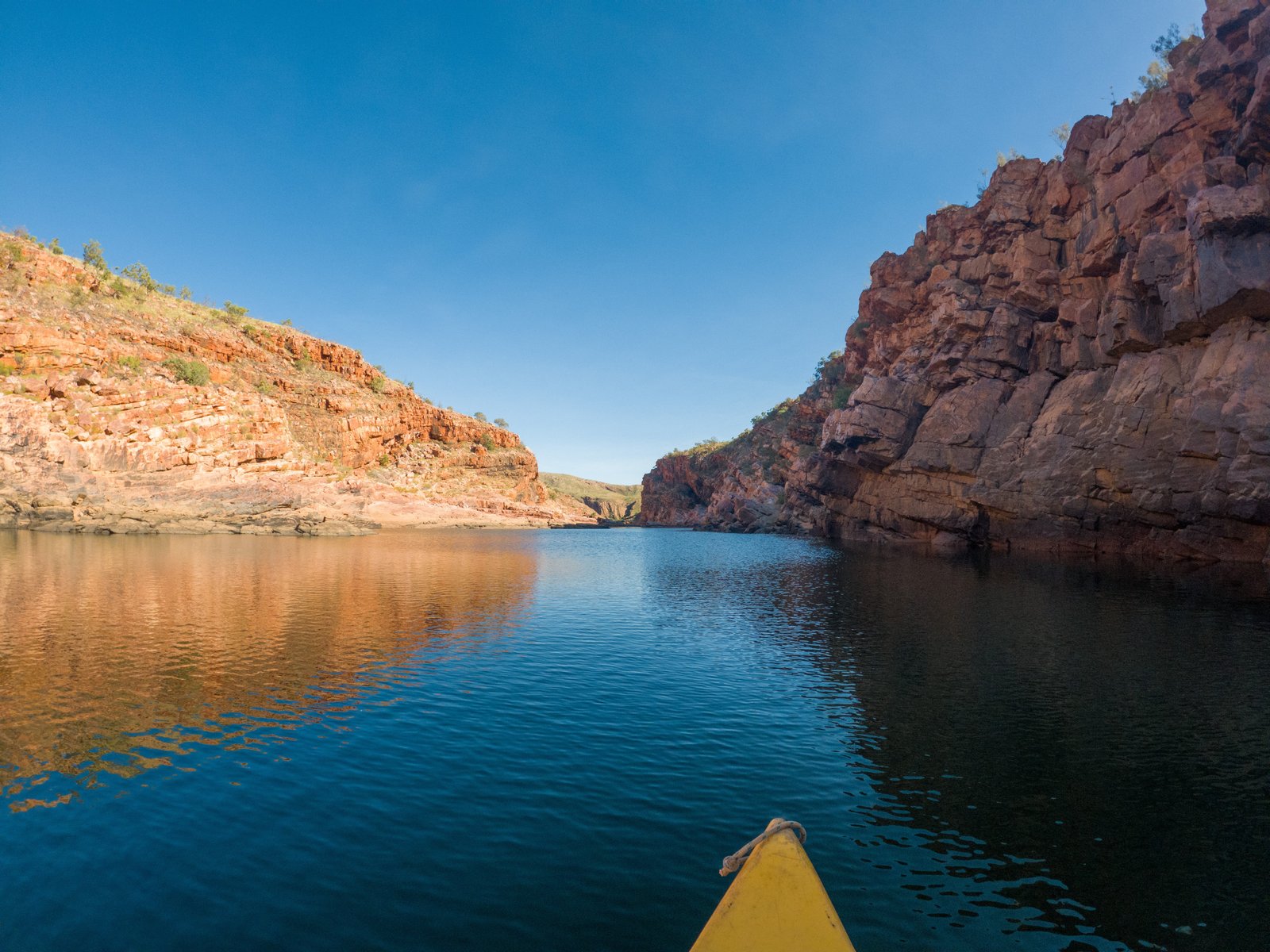
You can also hire canoes for Sir John Gorge, or there is a walking path along its entirety. Sir John Gorge is best visited in the afternoon as the setting sun lights up the gorge walls in brilliant colours.

The Annie Creek walk is popular for birdwatching; expect to see lots of olive and khaki outfits and telephoto lenses! Mornington is one of the best places to see the rare and colourful Gouldian Finch (which we sadly did not…guess we should have worn more olive/khaki).
MANNING GORGE
Manning Gorge at Mt Barnett Roadhouse simply cannot be missed; it is easily one of the most spectacular of the region and probably our favourite of the Gibb proper. Being one of the longer walks, it is recommended to allow for at least a half day here. Mt Barnett Roadhouse offers day-visit passes +/- camping in a large campground next to the Barnett River, convenient for a quick cool off on a hot day.
The walk itself to the gorge is part of the experience. It starts with a walk/swim through the Barnett River; floating containers are provided to keep personal items dry. From there, the track takes you through classic undulating Kimberley landscapes until you come around a corner, and there it is: Manning Gorge in all its grandeur. It is a massive area with a large swimming hole, impressive waterfall, plenty of lounging space, and overhangs with ancient Aboriginal art to discover. It is one of those places where you can easily lose a few hours actively exploring or simply sitting back admiring.

BARNETT RIVER GORGE
A short 60km from Manning Gorge is a not-very-advertised stop known as Barnett River Gorge (Jigngarrin). The year we visited, free camping was allowed and was one of our favourite camps along the Gibb. However, this seems to have changed sometime since then and is now only a day use area. It’s still worth a visit, particularly early in the season, to wander along this pretty gorge and have a dip in the pools at the end.

Believe it or not, this is only half of the Gibb River Road. Stay tuned for part two, the eastern side, including the awe-inspiring Mitchell Falls!

